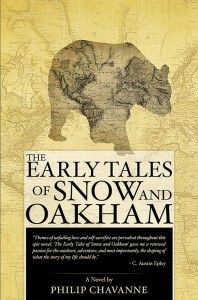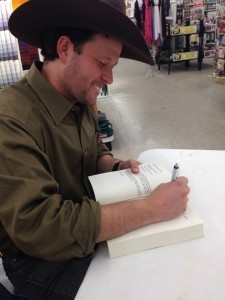Philip Chavanne’s The Early Tales of Snow and Oakham
 A sense of place is critical in engaging fiction. Oh, I suppose you could write some uomo senza nome-type landscape where characters interact in an unsubstantial vacuum. (Great dialogue, after all, can redeem a multitude of literary sins.) But the resulting book might not much connect with normal readers (though philosophers and critics of philosophers would no doubt love it). For us, however, no emotional attachment can be made to a character unless he, she, or it lives in a PLACE where we can picture ourselves setting our own feet.
A sense of place is critical in engaging fiction. Oh, I suppose you could write some uomo senza nome-type landscape where characters interact in an unsubstantial vacuum. (Great dialogue, after all, can redeem a multitude of literary sins.) But the resulting book might not much connect with normal readers (though philosophers and critics of philosophers would no doubt love it). For us, however, no emotional attachment can be made to a character unless he, she, or it lives in a PLACE where we can picture ourselves setting our own feet.
In a recent interview with Alaska magazine, Xulon author Philip Chavanne declares the importance of an immersive setting:
[T]he landscape played a vital role. An essential role. My hope all along was to write an adventure story that was both completely possible in every scene, and yet wild, dream-like, and enormous in its scope. I spent years trying to determine how to do that in the real world, and I eventually concluded that if it weren’t for the Alaska landscape such a story wouldn’t have been possible. The landscape is in many ways a character in itself.
Over the course of a quarter-million words, The Early Tales of Snow and Oakham takes readers on an epic journey around the world and back again. Every landscape—Alaska, Europe, Asia, India, Africa—is vividly drawn, and well they should be; Chavanne spent seven years traveling to all those places and chronicling the people and places he experienced. It is a story that almost literally defies description, a deeply affecting tale of forgiveness and redemption and destiny and what love looks like when you feel it with your entire being.
Have you trained as a writer?
When I was in college, I took screenwriting courses initially because I was passionate about storytelling and the idea of being a part of “the movies” was thrilling. However, I soon realized that screenwriting and fiction were two very different animals. I was far too stubborn and independent to hand over a story I’d bled for to a team of filmmakers. And my ability as a storyteller was far too limited to hold a reader’s attention for that long. So I focused my attention on learning the art of the short story. I enrolled in every course I could find on the subject, entered contests, and most importantly, I read short stories. I spent whole semesters reading and writing short stories. I soon learned that all good novels are simply culminations of good scenes. And I believed that if I could learn to write a good scene, just 7-10 pages that could hold a reader’s attention for every word, then I could in time build a prolonged narrative. So all of my training as a writer came in those early years of university courses, workshops, and my work with several writing mentors.
What were your inspirations for this particular story?
As far as inspirations go, Kanakuk Kamps was a place where I worked for three summers that radically changed my life and redirected my faith. It became undeniable that alongside my love for storytelling was an equal passion to work with children. So all of the elements of the book that have to do with children and caring for them with Christ’s love were inspired by Kanakuk Kamps. The other inspirations were from my travels.
Henry Snow and Jack Oakham have been a part of your life for a long time. What finally told you they were ready to meet the public?
The simplest answer was that I was finally finished. It took eleven years to write the book and another year for me to edit it, so I was ready to get it out there. But the simple truth was I had no idea how to do that. I manage a ranch in a small town, and when I need advice on a chainsaw I go to someone I trust about chainsaws and ask my questions. I have to trust that the person I’m dealing with knows one end of the chainsaw from the other and has cut down his share of trees. But with publishing, who do I turn to? I don’t know any novelists. I had no starting point , so I was literally in limbo. I could start submitting my book to random people I didn’t know, but for me that was like trusting a stranger with a chainsaw—someone was gonna get hurt.
I met Michelle Johnston in the Xulon Press booth at a ministry conference, spoke with her and submitted my prologue. Over the next few weeks, she read the book carefully and trust was established. My wife and I spoke on the phone with her about how we would move forward, and after some time in prayer, we decided it was time to move forward.

The author at the very first book signing for The Early Tales of Snow and Oakham
The publishing world has changed, is still changing, and many authors are shocked that writing the book is only the first, albeit the most important, part of the process. It’s been almost a year since your novel was published. Would you share what you’ve learned during the promotion and marketing phase of your work?
I’ve learned quite a bit. Once your book is complete, your work is not done. Now you have to tell your story and get the word out through social media and word of mouth. It can be hard work, but the rewards are crystal clear. I’ve also learned that what is more important than selling books is getting new readers and making them fans of your work. Readers talk about the books they’ve read, and it isn’t just for a few days after they finish. Oftentimes, it’s for many years. So while book sales are great, new fans do the work on the ground that no marketing plan ever could.
We’ve done several radio interviews and multiple book signings. We’ve been blessed that the book has been featured in half a dozen newspapers across the country, as well as Alaska Magazine. Last week [the first week of June 2014] the book became required reading in a high school in Colorado, so we will likely market to students in the future as well.
What should every first-time author know?
Read. That’s the first non-negotiable. Read the kind of books you would be proud to put your name on. Always explore something new.
When trying to write something magnificent, start small. Spend a whole day building One Great Sentence. Then you know you can. Now build a great paragraph. Then a great conversation. Ask yourself, “Who writes the best dialogue?” Read them and steal from them. They will be honored.
Be patient. Like a polaroid picture, good writing develops over time.
Phil’s interview with Alaska magazine can be read here. The Early Tales of Snow and Oakham will also be featured in Alaska’s July/August issue. His book is available from philipchavanne.com, as well as Amazon, Barnes and Noble, and the Xulon Press bookstore. Phil is always eager to connect with other writers, so feel free to reach out to him through social media or via his website, which also contains links to other appearances in the press.
Embrace your space.
The post Philip Chavanne’s The Early Tales of Snow and Oakham appeared first on Xulon Press, Christian Self Publishing.
Xulon Press Blog
- Peter Lopez Jr.'s profile
- 8 followers



